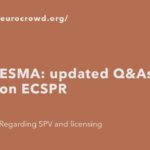ECSPR
ESMA publishes clarifications on use of SPV within ECSPR

The European Securities and Markets Authorities published clarifications on the use of Special Purpose Vehicles under ECSPR in a newly published Questions and Answers document on the European crowdfunding service providers for business Regulation. The purpose of the published document is to promote common supervisory approaches and practices in the application of the ECSPR. It aims at providing responses to questions posed by the general public, market participants and competent authorities in relation to the practical application of the ECSPR. The content of this document is aimed at competent authorities and crowdfunding service providers.
EUROCROWD welcomes the clarification especially with regard to the use of Special Purpose Vehicles as well as the liability of crowdfunding service providers. The clarification include more granular explanations on the use of special purpose vehicles for illiquid assets. The text argues, an asset should be deemed to be illiquid when it cannot be turned into cash swiftly. Factors such as, but not limited to, the following are indications that the asset may be illiquid:
- there is no organised market for assets of that type;
- sales for that type of assets usually take place over the counter;
- (there is no readily available value for assets of that type; or
- reaching an agreement on a selling price with a potential buyer encompasses significant costs (administrative fees, tax, audit and legal costs) and takes from a few weeks to a few months.
The text further argues that an asset should be deemed to be indivisible when it cannot be easily or swiftly divided into smaller, more moderately priced components for the purpose of its partial or total sale to investors or when such division in smaller component is not economically rational, notably because it prevents the asset from serving its core economical purpose. Factors such as, but not limited to, the following are indications that the asset may be indivisible:
- because of its legal structure, the asset cannot be divided or easily divided into smaller components that can be sold easily to investors (examples of such smaller component include, for instance, shares or units);
- due to the very nature of the underlying asset, it can only be divided into a limited number of components each with a value far exceeding the value usually expected for shares or units (e.g. a residential building which typically can only be divided into a limited number of apartments and not into components with a smaller value);
- due to the nature of its core economical purpose, the asset if divided would stop achieving its core economical purpose (e.g. a solar power plant dismantled into individual solar panels)
Read the full ESMA Q&A here
In a second document, ESMA published input from selected EU member states on their view on ECSPR for national implementation. This document can be found here

